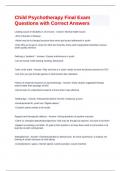Child Psychotherapy Final Exam
Questions with Correct Answers
Leading cause of disability in 15-19 y/os - Answer--Mental health issues
-45% of burden of disease
-Adults may be in therapy because they never got issues addressed in youth
-Only 25% w/ dx get tx- lower for SES and minority, those with marginalized identities receive
lower quality services
Defining a "problem" - Answer--Causes interference in youth
-Can be broad--toilet training, feeding, behavioral
Tools of the trade - Answer--Play and how it is used- needs to have functional outcome ie PCIT
-Use intro you get through games in interventions like relaxation
History of empirical research on psychotherapy - Answer--Early studies suggested therapy
wasn't better than passage of time
-Had to learn to understand research to know that it was effective
Teletherapy - Answer--Researched before COVID- enhances access
-Developmental fit- youth are "Digital natives"
-Consent- parent needs to be onsite
Rapport and therapeutic alliance - Answer--Strong predictor of positive outcome
-Client vs. therapist attitudes/perspectives- kids may be brought by parents, not want to be there
-Rapport is evolving, not static- #1 goal in first session is to have them want to come back or at
least be ok with coming back
Setting/format - Answer--Orienting families to teleservices- be more expressive, ie explain not
looking at screen because of note taking
-Considerations: space, internet speed, camera position, sound machine
,ESTs - Answer--Empirically supported treatment
-Clearly specified psychological treatments shown to be efficacious in controlled research with a
delineated population
Guiding principals for evidence-based practice for children and adolescents - Answer--Should
receive best available care based on scientific research and integrated with clinical expertise in
context of patient characteristics, culture and preferences. Quality care should be provided as
consistently as possible with their caregivers and families across settings
-Care systems should demonstrate responsiveness to youth and their families through
prevention, early intervention, treatment and continuity of care
-Equal access to effective care should cut across age, gender, sexual orientation and disability,
inclusive of all racial, ethnic and cultural groups
-Effectively implemented EBP requires a contextual base, collaborative foundation and creative
parternship among families, practitioners and researchers
Common criteria for EBP - Answer-At least 2 or more studies with the following:
1) Careful specification of the patient population
2) Random assignment of participants to conditions
3) Use of treatment manuals that document the procedure
4) Multiple outcome measures (raters, if used, are naive to conditions), including, of course,
measurement of the problem or disorder targeted in treatment
5) Statistically significant differences between treatment and comparison group after treatment
6) Replication of outcome effects, ideally by an independent investigator or research team
Evidence-based Practice in Psychology (EBPP) - Answer-The integration of the best available
research with clinical expertise in the context of patient characteristics, culture and preference
Interventions: all direct services rendered by psychologists
Includes: treatment, assessment, prevention
Empirically supported treatments (ESTs) - Answer-Clearly specified psychological treatments
shown to be efficacious in controlled research with a delineated population
Criteria: nature of comparison and outcome, study design, levels of efficacious "spectrum" vs
"categorical"
,EBP & Service delivery - Answer--Report builds on work of APA 2005 task force
-Of those with recognized disorder, few (20-30%) receive specialized MH care in a given year,
even fewer for certain populations
-Funding of health care for youth
-Systems approach- proximal and distal factors- micro, meso, exo, macro systems
What role does assessment play in EBP? - Answer--Deriving diagnoses
-Clinical formulation
-Intervention planning
-Outcome evaluation
-Identify strengths
-Psychometrics- looks at design, delivery and interpretation of tests that measure human
responses
Culture & EBP - Answer--Stratified sampling- divide subjects into subgroups called strata based
on characteristics they share (race, gender, educational attainment)
-Acculturation
-Ethical concerns with transporting EB interventions- culturally responsive (learn from people of
culture) vs. culturally competent (idea you can 'master' culture)
EBP and prevention - Answer--History: medical model and 'disease-oriented' approach
-Future vs. now orientation
-"Response to intervention"- multi-tier approach to early identification and support of students
with learning and behavior needs
-"At risk"- ethical identification concerns-- bad consequences of labelling, self-fulfilling prophecy,
victim blaming
Types of prevention programs - Answer--Health promotion- moves beyond focus on individual
behavior towards wide range of social and environmental interventions
-Universal- entire population
-Selective "at risk"- based on factor ie parents divorce
, -Indicated- sub threshold clinical symptoms
EBP & Treatment - Answer--Contrasted with prevention
-Structure: individual therapy with child, group therapy with children, focus of work is with
parents, multiple levels (eg child, caregivers, teachers, systems)
Meta-Analytic conclusions - Answer--Compared to adult psychotherapy?
-Follow up?
Precise rather than nonspecific
EBP & Types of evidence - Answer-RCT = "gold standard"
BUT may ignore/deemphasize things such as the therapist herself, therapeutic
relationship/working alliance, client's non diagnostic characteristics, 'process' variables in
treatment
-Use of other methodologies becoming more accepted, however RCTs - best source of scientific
information
-Meta-analysis and effect size: 0.2 small, 0.5 medium, 0.8 large
EBP and dissemination - Answer-Transportability: moving from lab to community
-Efficacy to effectiveness
-Bridging the gap
-Translating science into practice
EBP & Ethical challenges - Answer--Limited/inequitable access to EBP: social justice concern
-Transportability/fidelity of dissemination
-Treatment manuals as "cook books"
-Concern about 'treatment list' stemming from EBP
Developmental considerations - Answer-"Moving target"- downward vs upward developmental
presentation
-Considerations: natural settings, distress and differences by age, realistic coping- what is
actually possible? Ie may not work for child to walk away if they are insulted in their setting




